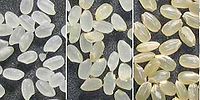- Japanese rice
-
Japanese Rice Scientific classification Kingdom: Plantae (unranked): Angiosperms (unranked): Monocots (unranked): Commelinids Order: Poales Family: Poaceae Genus: Oryza Species: O. sativa Variety: O. sativa var. japonica Trinomial name Oryza sativa var. japonica Japanese rice, or japonica, is a short-grain variety of rice (Oryza sativa var. japonica) which is characterized by its unique stickiness and texture. It also comes in a variety called mochigome (もち米sticky rice) which is used for making mochi (餅). Rice begins as brown rice, genmai (玄米), which may then be polished by a machine (精米機seimaiki), in which case it is sold as ready-polished or white rice, hakumai (白米). Sprouted brown rice hatsuga genmai (発芽玄米) is also sold in smaller quantities. It has a softer texture than brown rice and a pleasant fragrance, yet retains the health benefits of brown rice.[citation needed] Most supermarkets in Japan sell ready-polished rice in 10 kg, 5 kg, and smaller bags. Brown rice is usually sold in 30 kg bags. Japonica should not be confused with Jasponica rice – a cross between the long-grained and fragrant Thai Jasmine rice and the sticky, soft Japanese rice.
A spot with an automated rice polishing machine, called seimaijo (精米所), for polishing brown rice, are a common sight in rural Japan. The by-product of the polishing process, rice bran (米ぬかkomenuka) can be used for making a kind of pickle called nukazuke (ぬかづけ) or recycled as fertilizer. The rice polishing machines typically polish a 10 kg amount for 100 yen.
Contents
Cultivation
Rice is cultivated throughout Japan. In Hokkaidō, Japan's northernmost island, hardier varieties are grown. In Honshū, the Japanese mainland, varieties such as koshihikari(コシヒカリ) are grown.
Cultivation is highly mechanized, and almost all the planting and harvesting is done by machine.
The rice seeds are first soaked in water, then planted into trays under cover before being planted out when they have become big enough.
Rice fields cover many hillsides in rural Japan. Farmland is limited because so much of the country is mountainous.
Use
Rice is eaten in several ways in Japan, as plain rice "gohan" (飯?, lit. "cooked rice" or "meal of any sort") or often with a topping of furikake (ふりかけ), nattō (納豆) or nori (海苔), as well as for sushi (寿司). Leftover rice is often reused as ochazuke (茶漬け) (rice with green tea) or chāhan (チャーハン) (fried rice).
Rice is also used to make alcoholic drinks like sake (日本酒), rice vinegar, snacks such as senbei (煎餅), rice crackers, and agemochi (揚げ餅).
Preparation
Most Japanese use suihanki (rice cookers) to which measured amounts of washed rice and water are added. The rice is first washed to release excess starch. Then, before cooking it is usually soaked in water for a time between half an hour in summer, and two hours in winter. Soaking times depend on the quality and freshness of the rice, as well as on the season. The rice is then boiled using a ratio of about five parts of water to four parts of rice - though with fresher rice, the ratio can go down to 1-to-1. After this, it is steamed until the centre of the rice becomes soft. Salt is not added to the rice.
Traditionally, rice was eaten at every meal in Japan; most modern rice cookers can be set ahead by a timer, so that rice will be ready for the morning meal. The rice cooker can also keep rice moist and warm. Rice kept warm like this remains edible for several hours, so that rice need be made only once per day.
Prepared rice is usually served from the rice cooker into a chawan, or rice bowl.
After cooking, rice may also be held in a covered wooden box called an ohitsu.
Brown rice can be sprouted at home if it has not been irradiated or otherwise altered.
Trading
The Dojima Rice Market in Osaka was the first known futures market, with trading in rice contracts established sometime around 1730. This market ceased with economic controls in 1939. In 2005, the Tokyo Grain Exchange announced that it would create a futures contract on rice with trading starting in the summer of 2006. [1] However, the trading of these futures contracts has been postponed to an unspecified date since it has not been approved by the Japanese government. [2]
The Tokyo Grain Exchange was founded in 1952 in the same location as the Kakigaracho Rice Trading Exchange, established in 1874. [3] As of 2005, two varieties of Japanese rice were in consideration for standardization of the contract.
In order to fulfill self-sufficiency goals in Japan and to support domestic rice producers, the Japanese government enforces quotas and high tariffs on foreign rice. As a result, virtually all the rice consumed in Japan is domestically produced.
Cultivars grown outside Japan
Arborio rice and Baldo rice are cultivars of Japonica grown in Italy and other Mediterranean countries. Idly rice- the short grained and stout variety grown in Tamil Nadu (Sothern India) closely resembles japonica
See also
Varieties of rice - Ambemohar
- Arborio
- Aromatic rice
- Basmati
- Bhutanese red rice
- Black rice
- Bora saul
- Brown rice
- Calrose rice
- Camargue red rice
- Carnaroli
- Champa
- Dubraj
- Flattened rice
- Glutinous rice
- Golden rice
- Germinated brown rice (Hatsuga genmai)
- Hybrid rice
- Instant rice
- Japanese rice
- Jasmati
- Jasmine
- Koshihikari
- Matta rice
- Molakolukulu
- Nàng Thơm Chợ Đào
- Navara
- New Rice for Africa
- Nishiki rice
- Parboiled rice
- Patna rice
- Perennial rice
- Pokkali
- Ponni Rice
- Pusa 1121 Rice
- Red Cargo
- Samba
- Sasanishiki
- Semi-dwarf IR36
- Sona Masuri
- Weedy rice
- Wehani
- White rice
- Yamada Nishiki
Categories:- Japanese ingredients
- Varieties of rice
Wikimedia Foundation. 2010.

